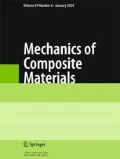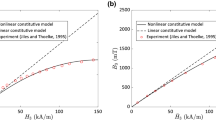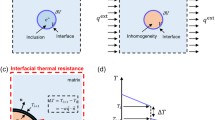A unified macro- and micromechanics constitutive model of fully coupled electro-magneto-thermo-elastic multiphase functional composites is developed. The model is based on the hypothesis of periods, the theory of uniformity, and the finite-volume direct averaging micromechanics (FVDAM). By introducing quadratic displacements and electric and magnetic potentials into the constitutive model, its accuracy is improved. The efficiency of the model is also raised by adopting surface-averaged quantities to be the primary variables of the original FVDAM. A numerical example is presented, and a relation between material constants and the fiber volume fraction is obtained.







Similar content being viewed by others
References
J. Aboudi, “Micromechanical analysis of composites by method of cells,” Appl. Mech. Reviews, 42, No. 7, 193-221 (1989).
M. Paley and J. Aboudi, “Micromechanical analysis of composites by the generalized cells method,” Mechanics of Materials, 14, No. 2, 127-139 (1992).
M. Pindera and B. A. Bednarcyk, “An efficient implementation of the generalized method of cells for unidirectional, multi-phased composites with complex microstructures,” Composites: Part B, 30, No. 2, 87-105 (1999).
J. Aboudi, M. Pindera, and S. M. Amold, “High-fidelity generalized method of cells for inelastic periodic multiphase materials,” NASA (2002).
Y. Bansal and M. Pindera, “Finite-volume direct averaging micromechanics of heterogeneous materials with elastic–plastic phases,” Int. J. of Plasticity, 22, No. 5, 775-825 (2006).
Y. Bansal and M. Pindera, “A second look at the higher-order theory for periodic multiphase materials,” J. of Appl. Mech.-Transactions of the Asme, 72, No. 3, 177-195 (2005).
Y. Bansal and M. Pindera, “Testing the Predictive Capability of the High-Fidelity Generalized Method of Cells Using an Efficient Reformulation. 2004, NASA.
H. Khatam and M. Pindera, “Parametric finite-volume micromechanics of periodic materials with elastoplastic phases,” Int. J. of Plasticity, 25, No. 7, 1386-1411 (2009).
Z. Sun, X. Gao, and Y. Song, “Efficient reformulation of 3-D high-fidelity generalized method of cells,” J. of Aerospace Power, 23, No. 7, 1318-1322 (2008).
Z. Sun, L. Lee, and B. Zhu, “Effect of inter-face layer parameters on uniaxial tensile behavior of ceramic matrix composites,” J. of Aerospace Power, 25, No. 3, 597-602 (2010).
Z. Sun, Y. Song, and D. Gao, “Efficient reformulation of 2-D high-fidelity generalized method of cells,” Acta Mechanica Solida Sinica, 26 (2005).
Z. Sun, Y. Song, and X. Gao, “An efficient implementation of the three dimensional GMC model and its application,” Mech. Sci. Technol., 26 (2005).
Z. Sun, Y. Song, and X. Gao, “Influence of macro-structural geometry the on thermal expansion coefficient of composites,” Chinese J. Appl. Mech., 21, No. 2 (2004).
J. Aboudi, Micromechanical Prediction of the Effective Coefficients of the Thermo-Piezoelectric Multiphase Composites. 1998.
Aboudi, J., Micromechanical Prediction of the Effective Behavior of Fully Coupled Electro-Magneto-Thermo-Elastic Multiphase Composites. 2000, NASA.
Acknowledgment
The partial support of this project provided by the National Basic Research Program of China, the National Natural Science Foundation of China (51075204), the Aeronautical Science Foundation of China (2012ZB52026), the Research Fund for the Doctoral Program of Higher Education of China (20070287039), and the NUAA Research Funding (NZ2012106) is gratefully acknowledged.
Author information
Authors and Affiliations
Corresponding author
Additional information
Russian translation published in Mekhanika Kompozitnykh Materialov, Vol. 50, No. 2, pp. 327-342, March-April, 2014.
Rights and permissions
About this article
Cite this article
Sun, Z., Niu, X., Huang, S. et al. A Unified Macro- and Micromechanics Constitutive Model of Fully Coupled Fields. Mech Compos Mater 50, 233–244 (2014). https://doi.org/10.1007/s11029-014-9410-6
Received:
Revised:
Published:
Issue Date:
DOI: https://doi.org/10.1007/s11029-014-9410-6




